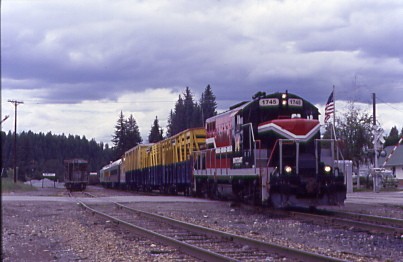
Up early at 5:30 AM and following checkout with a quick continental breakfast, I was off to Newport, Washington.
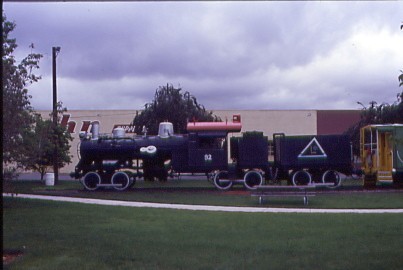

Potlatch Forests three truck Heisler 92, nee Ohio Match Company 1 built by the Heisler Locomotive Works in 1924. At some point it was bought by Potlatch in Headquarters, Idaho then in 1959, moved to Lewiston and in 1963, was donated to the City. It is on display in Locomotive Park.
During the 1890's, in northern Idaho's Palouse, Potlatch and Elk River basins, thousands of acres of timberland were being purchased by Midwestern companies, but most went to two men, William Deary of Northland Pine Company, a firm established by the Weyerhaeuser syndicate, and Henry Turrish of the Wisconsin Log & Lumber Company. Although competitors, the owners of the two railroads saw the value of collaboration and in 1903, merged their Idaho timberland under a new firm, called the Potlatch Lumber Company. The name, derived from the northwest Indian word "patshatl", which referred to an elaborate ceremony of gift-giving, was selected because the Potlatch River cut through the company's land.
Wood Briquettes, Inc., which manufactured and leased Pres-to-log machinery and marketed the logs, was a subsidiary of the Potlatch Corporation. Pres-to-logs were made from compressed wood shavings, sawdust and chips. The first machine began production in 1936. The patent for the machine expired in 1960 and the company eventually lost control over the machines and producers and in 1984 the directors consented to dissolve the company. All assets were transferred to the Potlatch Corporation.
I continued my drive on US 95 to Coeur D' Alene to Interstate 90, then Idaho Highway 41 to Rathdrum.
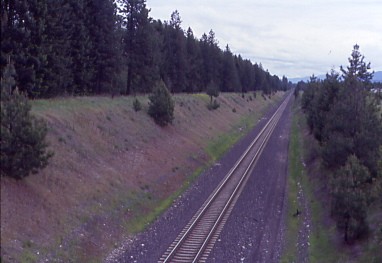
A very quiet BNSF Funnel at Rathdrum with no trains, after which I had lunch at an A&W then resumed my drive to Newport, Washington, where I put petrol in the car.
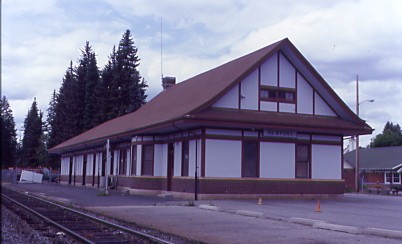
The Great Northern station at Newport built in 1910.
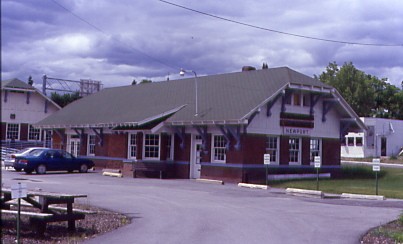
The Milwaukee Road (formerly Idaho Washington & Northern) station, built in 1909, which houses the Pend Oreille County Historical Society Museum.
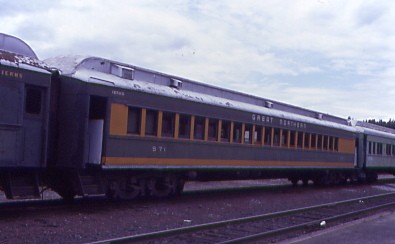
Part of today's consist was former Great Northern coach 971, built by Barney and Smith in 1914.
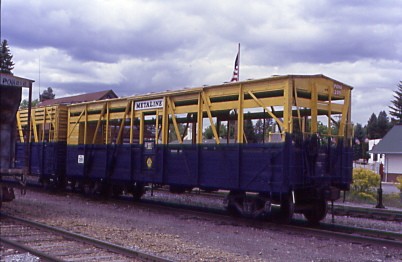
Open car "Metaline", also part of the consist.
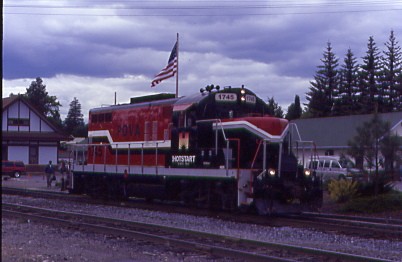
Pend Oreille Valley Railroad GP10 1745, ex. Chicago, Central & Pacific Railroad 1775, exx. Chicago, Central & Pacific Railroad 8045, exxx. Illinois Central Gulf 8045, nee Illinois Central GP9 9045 built by Electro-Motive Division in 1954.
Arriving early allowed for me to have a good look around at both stations before the locomotive arrived from Usk to switch our train. This also gave the few of us who arrived early several runbys before the train was spotted at the depot. Our train for this second rare mileage trip consisted of GP10 1745, POVA open car 205, POVA open car 256, POVA open car 207, former Great Northern coach 960, owned by the Inland Empire Railroad Historical Society, former Great Northern coach 971, former Pullman 12-1 sleeper converted into a coach 204 and caboose 2004.

Our train.
Pend Oreille Valley Railroad HistoryThe Pend Oreille Valley Railroad is made up of two sections of track, one former Milwaukee Road, and the other former Great Northern. The two lines originally crossed at Newport and the Pend Oreille Valley railroad has tied the two lines into one operation. We will be riding over the former Milwaukee Road trackage between Newport and Metaline Falls, Washington.
This part of the Pend Oreille Valley was built between 1907 and 1910 by the Idaho and Washington Northern Railroad (incorporated April 1, 1907), known as the Pend Oreille River Route. The railroad was built between Spokane and Metaline Falls by the Blackwell family to open the area up for their Blackwell Lumber Company. Frederick Blackwell moved to Idaho in 1902 after a number of years logging in Pennsylvania. By 1906, he and his partner, William Howard, controlled more than 100,000 acres of timber, but Blackwell sold out to the Monarch Timber Company. However, he took the money from this sale to buy more acreage and to build his railroad. Ini 1909, he formed Blackwell Lumber Company and later Panhandle Lumber Company, to log his new lands in Washington and Idaho. Besides the I&WN, Blackwell also built the Couer d'Alene and Spokane Railroad.
Besides the various logging companies and railroads that the Blackwell family owned, they also operated the Pend Oreille River Navigation Company, which provided freight and towing steamboat service on the river between Newport and Ione. The headquarters of the various companies was located in Spirit Lake, Idaho. The Chicago, Milwaukee & St. Paul (Chicago, Milwaukee, St. Pauul and Pacific after 1928) obtained ownership of the I&WN on January 25, 1916 (they gained control of the line in 1913 after saving the railroad from bankruptcy) and operated it as the Metaline Falls Branch. As part of the purchase, the Milwaukee acquired one of its few shay locomotives, a three-truck seventy ton "C" class steamer built for use hauling lumber trains to the Blackwell Lumber mills. The steamer became Chicago, Milwaukee and St. Paul 26 and went to the Couer d'Alene area being being sold off to a lumber company.
Lumber and mining dominated the freight movements on the line. More than 200 logging and lumber companies operated in the Pend Oreille Valley between the early 1900's and the late 1920's. Today, the US Forest Services and the Bureau of Land Management manages 59 percent of the land in Pend Oreille County. The population peaked at about 2,000 in the 1930's when the mills began to close. While at one time, there were plans to extend the line on into Canada to connect with the Canadian Pacific, the lines never got any further than Metaline Falls. However, the plans at least led to a nicely built and maintained railroad, one that was able to handle the 2-6-6-2 mallets that were banned from the Milwaukee's mainline due to their slow speed and tendency to freeze in cold weather.
The importance of the branch lines in this raea to the financial health of the Milwaukee Road's line to the west coast cannot be understated. The Metaline Branch was traditionally a part of Milwaukee Road's Idaho or Coast Division. when the Milwaukee Road abandoned its western lines, the Newport-Metaline Falls line was sold to the Port of Pend Oreille. When the line reopened as a shortline on October 1, 1979, it was operated and managed by Kyle Railways. This operation continued until 1984 when the Port took over operations. Today, the operation is based in Usk, Washington.
Passenger service on the Metaline Falls Branch was once fairly heavy. During the 1920's, at least two passenger trains a day ran in each direction - one a daily mixed train between Newport and Metaline Falls and another being a daily through passenger train between Spokane and Metaline Falls. The mixed train would take five-and-a-half hours to make the run from Newport to Metaline Falls (averaging just over eleven miles an hour) while passenger train 218-117 would take two hours and thirty-three minutes (averaging twenty-four miles an hour). This indicates that quite a bit of local freight was handled by Train 293. Since our excursion train will take about four hours to make the run and also consist of both passenger cars and open cars made from former freight cars, we will follow the lines using mixed train 293. By the way, passenger service ended on the line by the end of World War II.
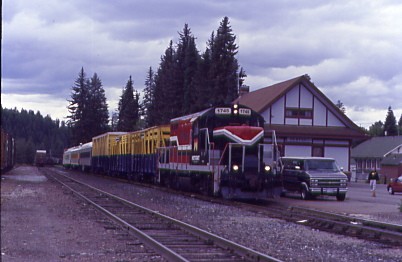
Our trip started off in front of the Great Northern station on former Great Northern tracks at 2:06 PM.
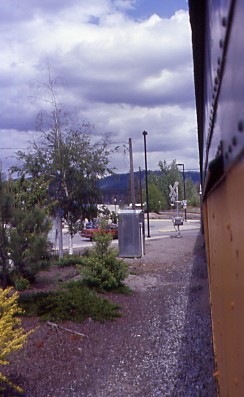
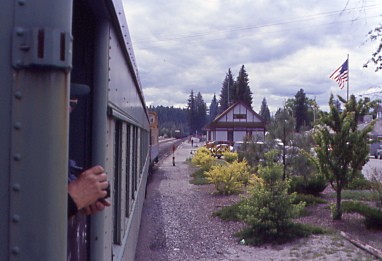
Leaving the former Great Northen tracks for the former Milwaukee Road tracks as I rode in coach 970. Our trip would follow the Pend Oreille River the entire way to Metaline Falls, which flows north into Canada where it joins the Columbia River. We travelled up this river in a valley between the Calispell Mountains {the 'c' is correct for the mountain range} to the west and the Selkirk Mountains to the east. We proceeded north out of Newport into the forests.
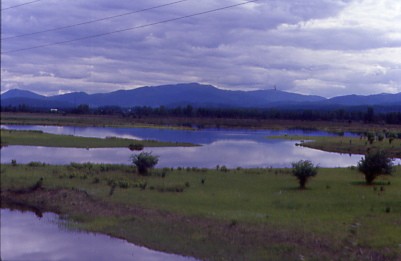
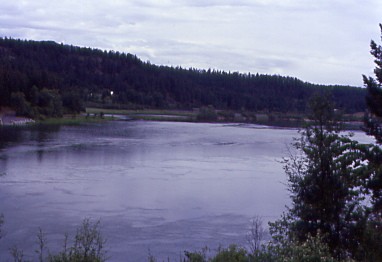
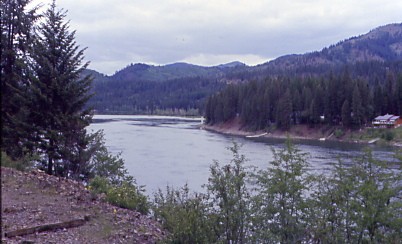
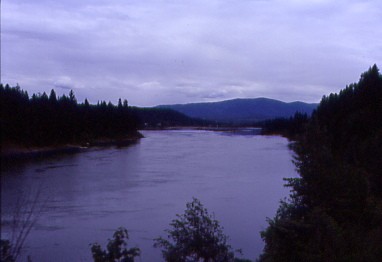
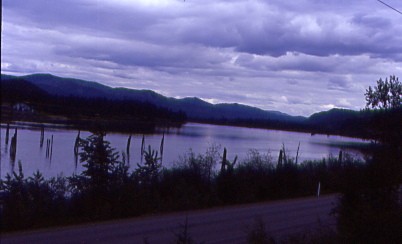
The river came into view as we passed Ashenfelter Bay at MP 44.9 and minutes later, crossed Washington Highway 20 for the first of several crossings, and would remain visible for most of the journey. We continued through Wolfred at MP 50.7 where the valley opened up then crossed McCloud Creek at MP 52.1, followed by Kent Creek at MP 53.6 and Brackett Creek at MP 55.3 before passing through Dalkena at MP 55.6. Our special train next crossed Davis Creek at MP 57.7 before we passed through Usk with its lumber industry.
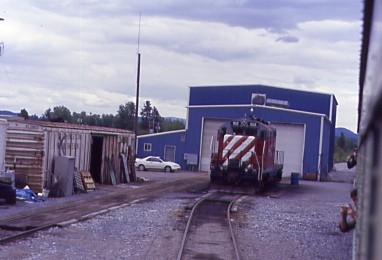
Pend Oreille Valley Railroad GP7 110, ex. Burlington Northern 1629, nee Northern Pacific 555 built by Electro-Motive Division in 1952 outside the shops in Usk.
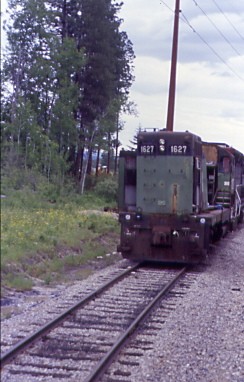
Pend Oreille Valley Railroad Shop dead line with Burlington Northern GP7 1627, nee Northern Pacific 553 built by Electro-Motive Division in 1951 in front. Other than a few car loadings north at Cusick, there is no revenue business north of Usk on this railroad. So from here to Metaline Falls, only the Lions Club excursion trains ply the rails through the most beautiful part of the railroad between Ione and Metaline Falls. Our train ran next through Cusick at MP 62.8, which is another former lumber town with a twenty car siding.
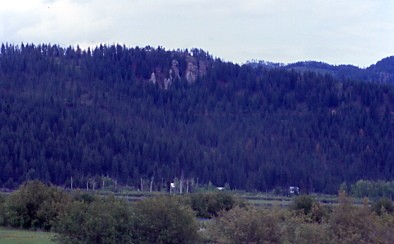
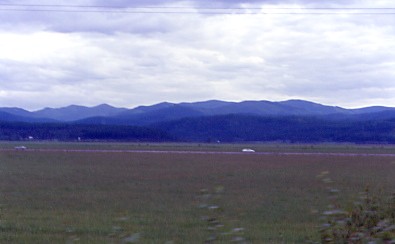
Calispell Mountain has a ski area on the slopes and there is a rock formation to the east that we shall call the "Calispell Indian Grotto". We later crossed both Trimble Creek at MP 66.3 and Tacoma Creek at MP 66.9 prior to running through Locke at MP 68.7. The creek crossings continued with our train running over both Cusick Creek at MP 70.3 and Parker Creek at MP 71.9 before reaching Jared at MP 72.6, with its 13-car siding. As we continued north, the train bridged Gardiner Creek at MP 72.9 before we arrived at Ruby, MP 77.6. The excursion then bridged Reynolds Creek at MP 77.9 and Ruby Creek at MP 81.4 before the valley narrowed into a canyon. At MP 81.5, we passed Blueslide siding, a seven-car affair before plunging into the 1,100 foot Blueslide Tunnel in total darkness at MP 82.0.
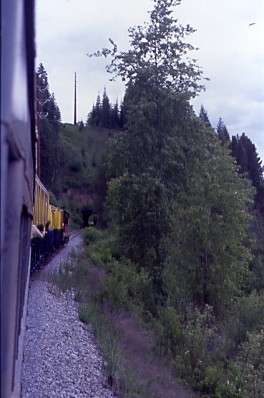
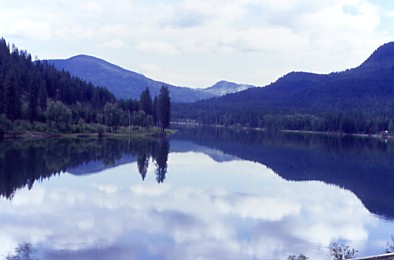
The train next trestled across Lost Creek at MP 85.5 then the South Fork of Lost Creek at MP 85.7 followed by another Lost Creek at MP 85.9. I guess that Lost Creek is truly lost. We reached Tiger, MP 91.0 with the general store and siding. Then it was across Renshaw Creek at MP 91.6, Diamond Creek at MP 92.0, Big Muddy Crek at MP 94.1 and Little Muddy Creek at MP 94.6 before we reached Ione at MP 95.1
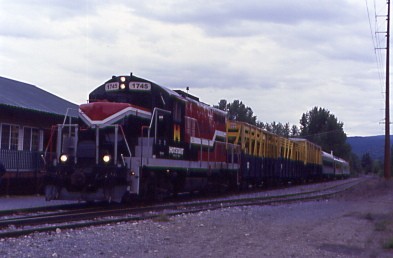
There we all detrained and here is our train at rest.
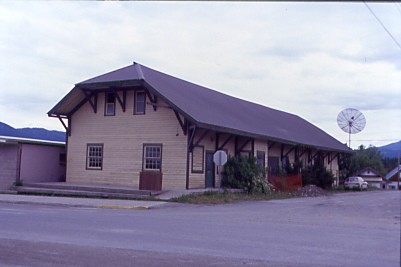
The Milwaukee Road station in Ione built in 1909 and relocated fifty feet east of its original location. I reboarded the open car for the most scenic part of the trip and free hot dogs were distributed to everyone on board.
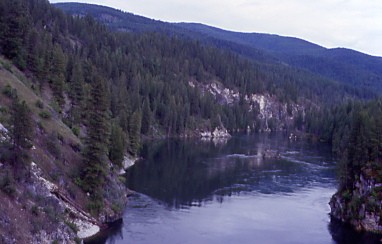
We departed Ione crossing Cedar Creek and Highway 20 for the last time as the canyon narrowed and made our way into Box Canyon.
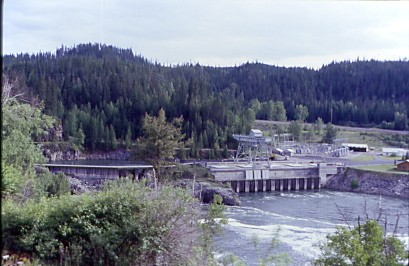
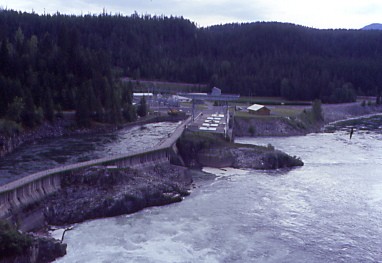
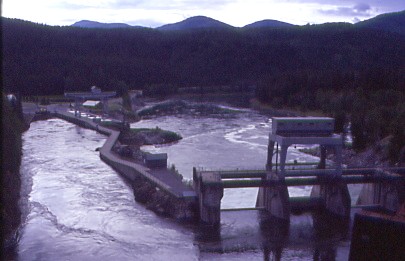
Box Canyon Dam at MP 982. This was built in 1952-1955 and is today owned and operated by the Pend Oreille Public Utility District, providing electrical power at rates much lower than found in most of the rest of Washington. We have followed the reservoir that is backed behind the dam for our entire trip since it extends more than 55 miles south to the Albeni Falls Dam east of Newport.
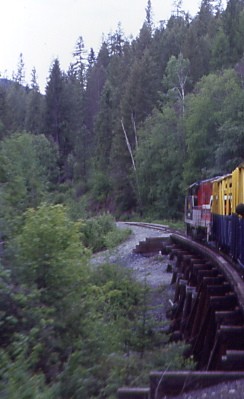
On another trestle, which is 475 feet long and 156 feet high. I took this photograph before the train was reversed off the bridge and slowly pulled forward for an exclusive photo runby for just three people. The Lions Club has a "no one off the train" policy between stations for safety reasons.
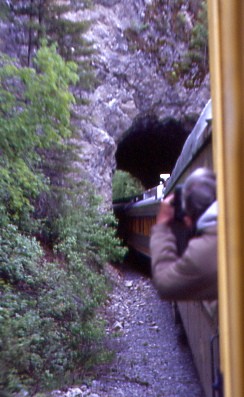
Entering Vail Tunnel at MP 99.7, which allows the rail line to cut its way through an extension of Sand Creek Montain, which forces the Pend Oreille River to swing west against Deer mountain and through a narrow canyon as it flows northward.
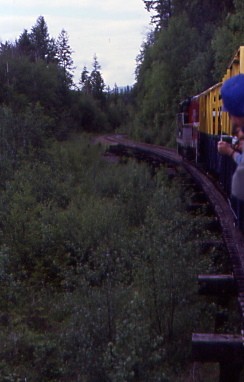
Exiting the 810 foot long Vail Tunnel in total darkness where we began a half-mile climb of 2.92 percent to a peak elevation of 2,152.55 feet, prior to crossing Sand Creek at MP 100.6 and Wolf Creek at MP 102.0. We next ran through the short 90 foot long Wolf Creek Tunnel at MP 102.2.

Climbing towards Metaline Falls. We crossed Pocahontas Creek at MP 102.9 followed by six more timber trestles in the next two miles before arriving at the yard at Metaline Falls.
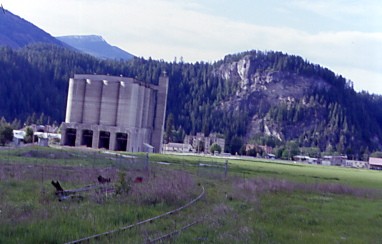
An old cement plant stands off to the northwest.
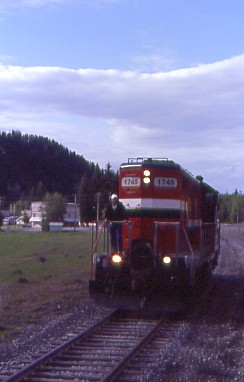
We stopped at the north end of the railroad, MP 104.7, only ten miles from Canada and I had almost crossed Washington from the south to north today. The locomotive ran around the train before we started the return journey.

On the way back to Ione, where we ended our second rare mileage trip of this weekend. The buses soon arrived and returned us to our waiting cars in Newport.
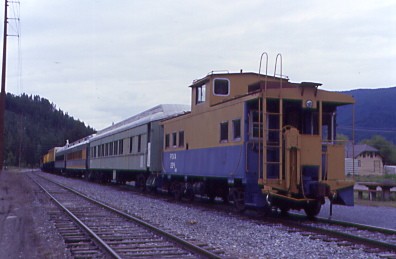
Our train at Ione at the end of a fabulous day of train-riding. Once back at the car, I drove Idaho Highway 41 to Interstate 90, which I took into Montana, arriving at Superior and checking into the Budget Host Inn just before midnight. After a quick check of my e-mail, I went to bed.
| RETURN TO THE MAIN PAGE |